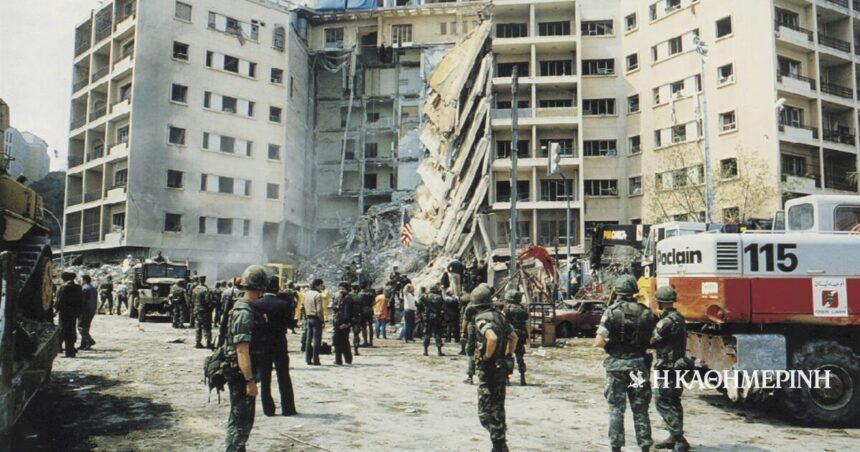At the end of the 1970s, and despite the Israel-Egypt truce which closed a serious war “front” of decades in the wider Middle East, other important events took place, which would determine regional and not only developments: The Iranian Revolution and the imposition of a theocratic anti-Western regime in Iran, the Soviet invasion of Afghanistan, as well as the ongoing and escalating civil war in Lebanon. Those events, combined with the Israeli invasion of Lebanon in June 1982 and the start of a new phase of the Arab-Israeli conflict, also caused the rapid growth of militant radical Islam. Thus, the ground became more suitable for the establishment of new, extreme, or even terrorist, Islamic organizations, such as the Shiite Hezbollah, which received varying degrees of support from Iran. She set as main goals the removal of foreign forces (except the friendly Syrians) from the territory of Lebanon and strengthening the influence of the Shiites. Although the official establishment of Hezbollah is placed in 1985, as early as 1982-83 its “precursor” armed organizations were founded, which later became its core, such as Islamic Jihad. She would be responsible for the deadly 1983 suicide bombings against the American embassy in Beirut and the barracks of the multinational Lebanese force.
The international intervention in Lebanon
Since August 1982, the US had been actively involved in Lebanon, both diplomatically and militarily. Initially, the US primarily sought to achieve the safe withdrawal of the leadership and the majority of PLO fighters from Beirut, which was besieged by Israeli troops. Military involvement consisted of the participation of US forces, deployed to Beirut as part of a multinational peacekeeping force (MNF) in August 1982, which also included smaller contingents of French, Italian and, later, British elite forces. The initial objective of the MNF was to oversee the fragile Israel-PLO truce (which had been agreed after American intervention) and the withdrawal of the latter from its strongholds in the Lebanese capital to Tunisia and other Arab countries.
Despite the evacuation of Beirut by the PLO in August, violence and instability in Lebanon escalated, particularly after the tragic events of September 1982, which marked the subsequent developments (ie the assassination of newly elected Lebanese President Bashir Gemayel and the massacres Palestinian refugees in the camps of Sabra and Satila). Then, the US government expanded the purposes of the US military presence in Beirut. The mission of the marines and the MNF in general would be to help the Lebanese authorities control the situation.
However, in this new mission the American and other MNF forces failed miserably. Despite the US government’s repeated declarations that they would carry out purely peaceful tasks, the deployment of Western military units was seen by many Muslim organizations, particularly pro-Iranian and anti-Western armed groups, as meddling in Lebanese affairs in favor of the (Christian Maronite-dominated) government and Christian militias that they helped her. Indeed, gradually, American forces, especially ships and aircraft, provided limited support to the Lebanese army. It was in this environment of escalating violence and chaos in Lebanon and growing anti-Americanism especially on the part of pro-Iranian Shiite organizations that the major terrorist attacks that took place in Beirut in 1983 were planned and executed.
First target is the US embassy
The first target was the American embassy. That attack was carefully planned. The attackers appeared to have received training and other support from the Iranian Revolutionary Guards, knew the embassy’s layout in detail, as well as security gaps. On April 18, 1983, a suicide bomber drove a van loaded with approximately 900 kilograms of explosives into the US Embassy in Beirut. The vehicle breached the security perimeter and the explosion caused massive destruction to a large part of the building. The toll was the death of 63 people, including 17 Americans.
The bombing at the US embassy led to an increase in the number and scale of armed incidents that had already begun to occur between US Marines and local Muslim militants. Frictions, both at the diplomatic level and on the field, have also existed between the US and Israel. Thus, already in the middle of 1983, the inability of the Reagan administration to influence the developments in Lebanon had become clear. Efforts to reach an agreement for the mutual withdrawal of Syrian and Israeli forces from Lebanon failed, and in early September 1983 the Israelis suddenly withdrew from the outskirts of Beirut, collapsing into a “security zone” in southern Lebanon. Thus, MNF forces became much more vulnerable to attacks by Islamic organizations or (pro)Syrian forces.
Mass casualties in Lebanese peacekeeping force barracks
On October 23, 1983, the deadliest terrorist attack took place against US Marine barracks, as well as that against French paratroopers, at Beirut International Airport, where the MNF was based. The attack against the US Marines was the second-deadliest terrorist act in history (only the 1978 Rex Cinema fire in Abadan, Iran, had more victims), and is one of the deadliest terrorist attacks ever take place against US military personnel. And that attack was carefully planned and required extensive reconnaissance and logistical support, after the attackers first studied the vulnerabilities in the barracks’ security measures. A suicide bomber drove a truck there loaded with about five and a half tons of explosives, which he detonated after breaching the security perimeter. The explosion caused the building to collapse, resulting in massive casualties: 220 marines and 21 other US military personnel were recovered dead. At the same time, another suicide bomber blew himself up in the French barracks, killing 58 paratroopers.
In its history, the Marine Corps had not suffered more casualties in a single day than in the deadly battles of Iwo Jima and Okinawa. The Reagan administration found itself confused, with the president initially appearing ready to launch military retaliation as soon as “there was clear evidence of the perpetrators of the attack” to “reassert American leadership” and “reclaim the initiative.” However, there was no US strike against enemy forces in Lebanon or against Syria or Iran. The Pentagon opposed further escalation and favored a withdrawal of Marines from Lebanon.


The departure of MNF
A new episode occurred in early December 1983. When Syrian air defenses attacked an American reconnaissance aircraft east of Beirut, the American government attempted to respond forcefully by ordering an air strike by forces of the Sixth Fleet. The raid, however, ended in fiasco, as it produced no tangible result, but ended with the downing of two American fighter jets. At the same time, Marines still stationed at Beirut International Airport suffered further casualties, as eight were killed by artillery fire from Syrian/pro-Syrian forces. The impasse of the American involvement in Lebanon and the absence of a clear strategy had become obvious. Thus, in February 1984, the withdrawal of the marines and, of course, the other detachments of the MNF was ordered.
The deadly terrorist suicide bombings of 1983 were a landmark in the history of international Islamic terrorism and had many consequences. First of all, the limits of American influence and power in the wider region were demonstrated, especially when Washington was not prepared to proceed with major involvement using strong military forces. Reagan’s desire to strengthen the US footprint in the Middle East and North Africa through the show (not necessarily the use) of military power resulted in a fiasco bigger than the failed operation to rescue the American hostages from the Tehran embassy during his predecessor’s presidency, Jimmy Carter. As later noted, in October 1983, radical Islamists “inflicted the greatest defeat of American forces at the tactical level since the era of the Korean War.” But the consequences were not just at the tactical level. Overall, the American intervention in Lebanon registered as a major failure of the Reagan administration. Diplomatic mediation failed. Support for the weak Lebanese army proved insufficient and futile. The presence of American and other Western military detachments, instead of contributing to stabilization and peace, provoked the reaction of extreme militant Islamic organizations and the anti-Western states that supported them.
The terrorist attacks of 1983 demonstrated, on the one hand, the vulnerability of high-value American targets, and on the other, the effectiveness of these new unorthodox warfare tactics based on suicide bombings, influencing the future course of action of various terrorist Islamic organizations internationally. Thus, the incidents of anti-Western and especially anti-American terrorism both in Lebanon and in neighboring countries continued. Kidnapping of Americans in Lebanon has become an endemic phenomenon. At the same time, new bloody bombings took place against the American embassy in Kuwait and, again, in Beirut.
Mr. Dionysis Hourchoulis is an assistant professor at the History Department of the Ionian University.
Edited by: Evanthis Chatzivasiliou




